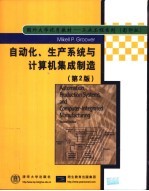图书介绍
自动化、生产系统与计算机集成制造 英文版PDF|Epub|txt|kindle电子书版本下载

- Mikell P.Groover著 著
- 出版社: 北京:清华大学出版社
- ISBN:7302054843
- 出版时间:2002
- 标注页数:856页
- 文件大小:54MB
- 文件页数:871页
- 主题词:生产过程-自动化系统-高等学校-教材-英文;计算机集成制造-高等学校-教材-英文
PDF下载
下载说明
自动化、生产系统与计算机集成制造 英文版PDF格式电子书版下载
下载的文件为RAR压缩包。需要使用解压软件进行解压得到PDF格式图书。建议使用BT下载工具Free Download Manager进行下载,简称FDM(免费,没有广告,支持多平台)。本站资源全部打包为BT种子。所以需要使用专业的BT下载软件进行下载。如BitComet qBittorrent uTorrent等BT下载工具。迅雷目前由于本站不是热门资源。不推荐使用!后期资源热门了。安装了迅雷也可以迅雷进行下载!
(文件页数 要大于 标注页数,上中下等多册电子书除外)
注意:本站所有压缩包均有解压码: 点击下载压缩包解压工具
图书目录
Chapter 1 INTRODUCTION1
1.1 Production System Facilities2
1.2 Manufacturing Support Systems7
1.3 Automation in Production Systems9
1.4 Manual Labor in Production Systems14
1.5 Automation Principles and Strategies17
1.6 Organization of the Book21
Chapter 2 MANUFACTURING OPERATIONS24
2.1 Manufacturing Industries and Products28
2.2 Manufacturing Operations31
2.3 Product/Production Relationships35
2.4 Production Concepts and Mathematical Models40
2.5 Costs of Manufacturing Operations48
PART Ⅰ: AUTOMATION AND CONTROL TECHNOLOGIES61
Chapter 3 INTRODUCTION TO AUTOMATION61
3.1 Basic Elements of an Automated System63
3.2 Advanced Automation Functions71
3.3 Levels of Automation76
Chapter 4 INDUSTRIAL CONTROL SYSTEMS79
4.1 Process Industries versus Discrete Manufacturing Industries80
4.2 Continuous versus Discrete Control82
4.3 Computer Process Control88
4.4 Forms of Computer Process Control96
Chapter 5 SENSORS,ACTUATORS,AND OTHER CONTROL SYSTEM COMPONENTS107
5.1 Sensors108
5.2 Actuators111
5.3 Analog-to-Digital Conversion112
5.4 Digital-to-Analog Conversion115
5.5 Input/Output Devices for Discrete Data117
Chapter 6 NUMERICAL CONTROL120
6.1 Fundamentals of NC Technology122
6.2 Computer Numerical Control128
6.3 DNC134
6.4 Applications of Numerical Control137
6.5 NC Part Programming145
6.6 Engineering Analysis of NC Positioning Systems179
Chapter 6 APPENDIX:APT WORD DEFINITIONS196
Chapter 7 INDUSTRIAL ROBOTICS210
7.1 Robot Anatomy and Related Attributes212
7.2 Robot Control Systems218
7.3 End Effectors220
7.4 Sensors in Robotics222
7.5 Industrial Robot Applications222
7.6 Robot Programming230
7.7 Engineering Analysis of Industrial Robots240
Chapter 8 DISCRETE CONTROL USING PROGRAMMABLE LOGIC CONTROLLERS AND PERSONAL COMPUTERS257
8.1 Discrete Process Control257
8.2 Ladder Logic Diagrams264
8.3 Programmable Logic Controllers268
8.4 Personal Computers Using Soft Logic275
Part Ⅱ: MATERIAL HANDLING AND IDENTIFICATION TECHNOLOGIES281
Chapter 9 INTRODUCTION TO MATERIAL HANDLING281
9.1 Overview of Material Handling Equipment282
9.2 Considerations in Material Handling System Design285
9.3 The 10 Principles of Material Handling288
Chapter 10 MATERIAL TRANSPORT SYSTEMS292
10.1 Industrial Trucks293
10.2 Automated Guided Vehicle Systems295
10.3 Monorails and Other Rail Guided Vehicles302
10.4 Conveyor Systems303
10.5 Cranes and Hoists309
10.6 Analysis of Material Transport Systems311
Chapter 11 STORAGE SYSTEMS328
11.1 Storage System Performance329
11.2 Storage Location Strategies331
11.3 Conventional Storage Methods and Equipment332
11.4 Automated Storage Systems335
11.5 Engineering Analysis of Storage Systems344
Chapter 12 AUTOMATIC DATA CAPTURE357
12.1 Overview of Automatic Identification Methods358
12.2 Bar Code Technology361
12.3 Other ADC Technologies370
PART Ⅲ:MANUFACTURING SYSTEMS375
Chapter 13 INRODUCTION TO MANUFACTURING SYSTEMS375
13.1 Components of a Manufacturing System376
13.2 Classification of Manufacturing Systems381
13.3 Overview of the Classification Scheme388
13.4 Manufacturing Progress Functions (Learning Curves)392
Chapter 14 SINGLE STATION MANUFACTURING CELLS397
14.1 Single Station Manned Workstations398
14.2 Single Station Automated Cells399
14.3 Applications404
14.4 Analysis of Single Station Cells409
Chapter 15 GROUP TECHNOLOGY AND CELLULAR MANUFACTURING420
15.1 Part Families422
15.2 Parts Classification and Coding425
15.3 Production Flow Analysis431
15.4 Cellular Manufacturing434
15.5 Application Considerations in Group Technology439
15.6 Quantitative Analysis in Cellular Manufacturing442
Chapter 16 FLEXIBLE MANUFACTURING SYSTEMS460
16.1 What is an FMS?462
16.2 FMS Components469
16.3 FMS Applications and Benefits480
16.4 FMS Planning and Implementation Issues485
16.5 Quantitative Analysis of Flexible Manufacturing Systems487
Chapter 17 MANUAL ASSEMBLY LINES514
17.1 Fundamentals of Manual Assembly Lines516
17.2 Alternative Assembly Systems523
17.3 Design for Assembly524
17.4 Analysis of Single Model Assembly Lines525
17.5 Line Balancing Algorithms534
17.6 Mixed Model Assembly Lines540
17.7 Other Considerations in Assembly Line Design552
18.1 Fundamentals of Automated Production Lines565
Chapter 18 TRANSFER LINES AND SIMILAR AUTOMATED MANUFACTURING SYSTEMS566
18.2 Applications of Automated Production Lines575
18.3 Analysis of Transfer Lines with No Internal Storage579
18.4 Analysis of Transfer Lines with Storage Buffers587
Chapter 19 AUTOMATED ASSEMBLY SYSTEMS601
19.1 Fundamentals of Automated Assembly Systems602
19.2 Design for Automated Assembly606
19.3 Quantitative Analysis of Assembly Systems610
PART Ⅳ:QUALITY CONTROL SYSTEMS631
Chapter 20 INTRODUCTION TO QUALITY ASSURANCE631
20.1 Quality Defined633
20.2 Traditional and Modern Quality Control635
20.3 Taguchi Methods in Quality Engineering638
20.4 ISO 9000648
Chapter 21 STATISTICAL PROCESS CONTROL654
21.1 Process Variability and Process Capability655
21.2 Control Charts658
21.3 Other SPC Tools667
21.4 Implementing Statistical Process Control672
Chapter 22 INSPECTION PRINCIPLES AND PRACTICES681
22.1 Inspection Fundamentals682